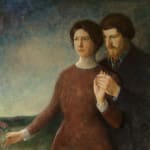Charles Webster Hawthorne 1872-1930
The Lovers
Tempera on panel
40 x 40 inches
101.6 x 101.6 cm
Framed dimensions: 44 1/8 x 44 1/8 inches
101.6 x 101.6 cm
Framed dimensions: 44 1/8 x 44 1/8 inches
Signed lower right: C.W. Hawthorne
Like his mentor the great American Impressionist William Merritt Chase, Charles Webster Hawthorne was equally admired in his own lifetime as both a talented painter and a highly influential instructor. Hawthorne first studied with Chase at his Shinnecock Summer School of Art, which was specifically dedicated to open-air landscape painting. Not only did Hawthorne quickly absorb all the principles of Chase’s instruction, but he also became determined to found his own school based on the same model. In 1899 Hawthorne discovered the small fishing village of Provincetown on the furthermost tip of Cape Cod, and after purchasing a large house on Miller Hill, he opened the Cape Cod School of Art, which was an immediate success.
While Hawthorne’s own approach as a teacher owed much to Chase, he developed a distinctly unique painting style and teaching method that defies easy categorization. Hawthorne was greatly impressed with the work of Franz Hals, which he saw during his trip to Holland in the summer of 1898. He was particularly struck by Hals’ Regentesses of the Old Men’s Almhouse, and from this work he absorbed a deep appreciation for the power of human expression and an economy of technique. Hawthorne applied these lessons to his own realistic portraits of Provincetown fishermen and their families; these works have a somber almost melancholy quality to them, as they reveal the vulnerability of the human condition.
Stylistically, Hawthorne maintained a life-long commitment to the importance of color. “Beauty in art,” he said, “is the delicious notes of color one against the other.” Of equal importance to him was capturing the effects of light. He told his students: “Everything in painting is a matter of silhouettes. Hold light against shadow, not light against light.” He developed a particular technique of layering glazes and texturing the surface of this paintings, which heightens the relationship between the color and creates a light effect that seems to emanate from within the painting. These stylistic techniques in combination with his straightforward compositions of one or more figures shown at close range create the hallmarks of Hawthorne’s best paintings. In The Lovers, the two figures stand in the foreground against a spare but glowing background. The way they hold hands is a tender reflection of their relationship to one another. Her outward and his inward gaze speaks to the pathos that Hawthorne’s best paintings beautifully capture.
While Hawthorne’s own approach as a teacher owed much to Chase, he developed a distinctly unique painting style and teaching method that defies easy categorization. Hawthorne was greatly impressed with the work of Franz Hals, which he saw during his trip to Holland in the summer of 1898. He was particularly struck by Hals’ Regentesses of the Old Men’s Almhouse, and from this work he absorbed a deep appreciation for the power of human expression and an economy of technique. Hawthorne applied these lessons to his own realistic portraits of Provincetown fishermen and their families; these works have a somber almost melancholy quality to them, as they reveal the vulnerability of the human condition.
Stylistically, Hawthorne maintained a life-long commitment to the importance of color. “Beauty in art,” he said, “is the delicious notes of color one against the other.” Of equal importance to him was capturing the effects of light. He told his students: “Everything in painting is a matter of silhouettes. Hold light against shadow, not light against light.” He developed a particular technique of layering glazes and texturing the surface of this paintings, which heightens the relationship between the color and creates a light effect that seems to emanate from within the painting. These stylistic techniques in combination with his straightforward compositions of one or more figures shown at close range create the hallmarks of Hawthorne’s best paintings. In The Lovers, the two figures stand in the foreground against a spare but glowing background. The way they hold hands is a tender reflection of their relationship to one another. Her outward and his inward gaze speaks to the pathos that Hawthorne’s best paintings beautifully capture.
WHY WE LOVE IT
While Hawthorne was a highly versatile artist who experimented with a variety of painting styles throughout his career, he produced a significant body of figurative works. In The Lovers, the two figures stand in the foreground against a spare but glowing background. The way they hold hands is a tender reflection of their relationship to one another. Her outward and his inward gaze speaks to the pathos that Hawthorne’s best paintings beautifully capture.
Provenance
Sotheby's, New York, March 17, 1988, lot 219;Berry-Hill Galleries, New York;
Sotheby's, New York, May 25, 2001, lot 46;
Hollis Taggart Galleries, New York;
Private collection, New York, until 2023
Exhibitions
Memorial Art Gallery, Rochester, New York, "Looking Back: A perspective on the 1913 Inaugural Exhibition," October 9-November 20, 1988.Please join our mailing list
* denotes required fields
We will process the personal data you have supplied in accordance with our privacy policy (available on request). You can unsubscribe or change your preferences at any time by clicking the link in our emails.



